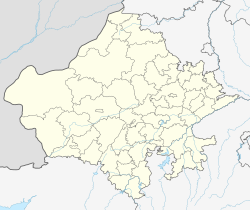Chandravati
| Chandravati | |
|---|---|
| village | |
| Location in Rajasthan, India | |
| Coordinates: 24°27′00″N 72°46′00″E / 24.45000°N 72.76667°ECoordinates: 24°27′00″N 72°46′00″E / 24.45000°N 72.76667°E | |
| Country |
|
| State | Rajasthan |
| Languages | |
| • Official | Hindi |
| Time zone | IST (UTC+5:30) |
Chandravati (Hindi: चन्द्रावती), popularly known as Chandroti, is a village situated near Abu Road on the bank of the West Banas River in the Indian state of Rajasthan. In ancient times it was an extensive town, and present villages such as Dattani, Kiverli, Kharadi and Santpura were its suburbs. The old ruins, such as temples, torans and images scattered over the large area, bear testimony to its past glory.
Archeological excavations suggested that there was a large settlement at the place before the establishment of Chandravati by Paramaras. Chandravati was ruled by the Paramaras of Abu. The first Paramara ruler of the area was Sindhuraja in the early tenth century.
Chandravati was the major city in past said to once been eighteen miles in circuit. Its prosperity seems to have lasted from the seventh to the beginning of the fifteenth century. Tradition gives it an earlier origin than Dhar, making it the metropolis of Western India, when the Parmara was paramount lord to whom the nine castles of the desert were the grand subordinate fiefs. In the seventh century, then subordinate to Dhar, it proved a place of refuge to Raja Bhoj, when, by some northern invader, he was forced to flee from his capital. From the Parmars it was wrested by the Chauhan chieftains of Sirohi, and, on the establishment of the Chaulukya dynasty of Anhilwad Patan (942) the rulers of Chandravati became its vassals. The remains at Chandravati and on mount Abu seem to point to the eleventh and twelfth centuries as the time of greatest wealth and splendour. The materials recovered by excavation suggested that it was established around 7th century and expanded into a large settlement (about 50 hectare) around 10th or 11th century when it was a capital township.
In 1024 AD, Chandravati was attacked and plundered by Mahmud Ghazni when he passed through Rajasthan to attack Anhilwad Patan. After defeating Prithviraj III in 1192 AD, the Muslim army also attacked Chandravati.
...
Wikipedia


